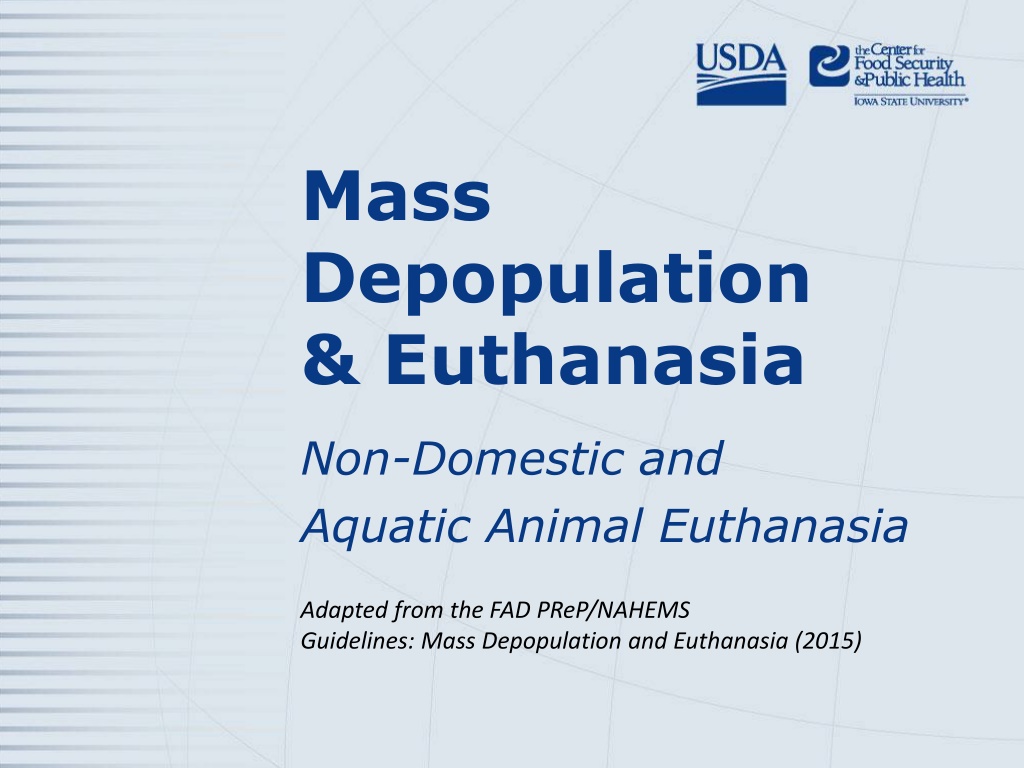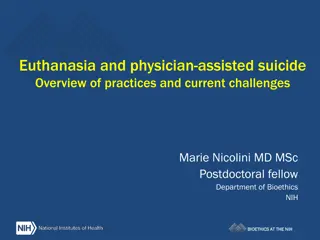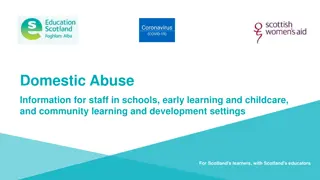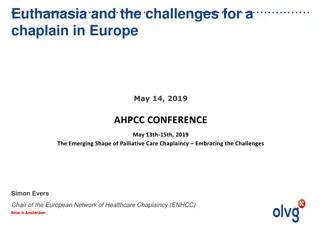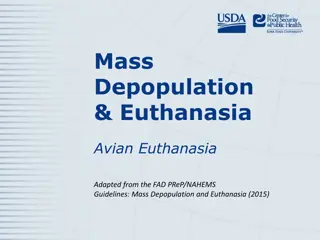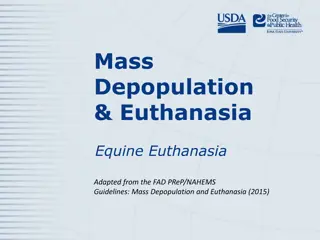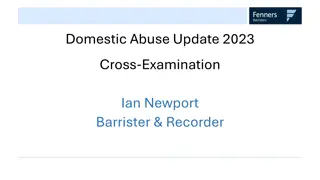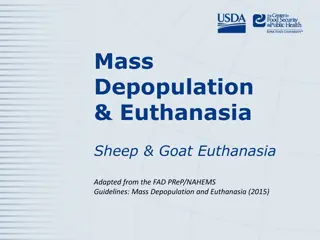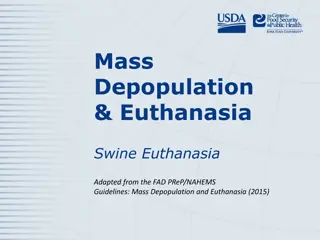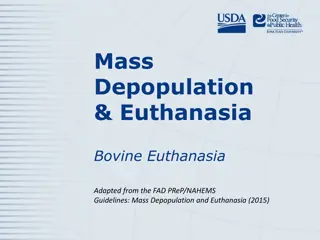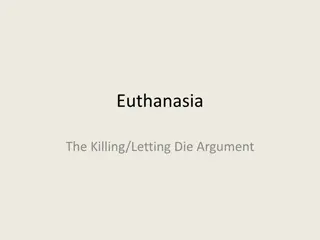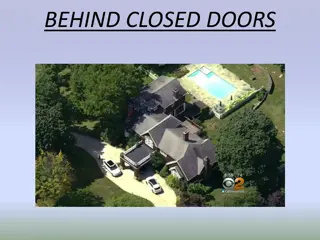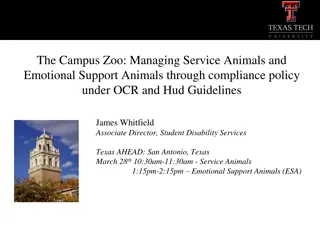Guidelines for Euthanasia and Depopulation of Non-Domestic Animals
These guidelines outline the procedures for humane euthanasia and mass depopulation of non-domestic animals, emphasizing painless transitions and stress-free processes. Key aspects include handling, selection of acceptable methods, minimizing emotional impact, safeguarding the food chain, and preventing disease spread during animal health emergencies. Expert consultation, appropriate facilities, and trained personnel are crucial for the humane treatment and welfare of non-domestic animals.
Download Presentation

Please find below an Image/Link to download the presentation.
The content on the website is provided AS IS for your information and personal use only. It may not be sold, licensed, or shared on other websites without obtaining consent from the author. Download presentation by click this link. If you encounter any issues during the download, it is possible that the publisher has removed the file from their server.
E N D
Presentation Transcript
Mass Depopulation & Euthanasia Non-Domestic and Aquatic Animal Euthanasia Adapted from the FAD PReP/NAHEMS Guidelines: Mass Depopulation and Euthanasia (2015)
Non-Domestic Zoological and Exhibition Animals
Euthanasia and Depopulation Euthanasia Transitioning painlessly and stress-free as possible Mass Depopulation Large numbers, quickly and efficiently Consideration to welfare as practicable Terms used interchangeably here FAD PReP/NAHEMS Guidelines: MDE-Non-Domestic Animals USDA APHIS and CFSPH
Euthanasia and Depopulation May be practiced during an animal health emergency Goals of Euthanasia Provide humane treatment Select acceptable method Minimize negative emotional impact Safeguard food chain Prevent or mitigate disease spread FAD PReP/NAHEMS Guidelines: MDE-Non-Domestic Animals USDA APHIS and CFSPH
Handling Goal: Humane Treatment Careful restraint and handling to minimize distress, pain, and injury Appropriate facilities Humane and compatible with species involved Competent, experienced personnel FAD PReP/NAHEMS Guidelines: MDE-Non-Domestic Animals USDA APHIS and CFSPH
Non-Domestic Animals Consult with experts when designing euthanasia plan Zoo animals: USDA support Game park animals: USDA lead Handled only by trained personnel May not metabolize drugs, handle stress like domestic species FAD PReP/NAHEMS Guidelines: MDE-Non-Domestic Animals USDA APHIS and CFSPH
Euthanasia- Free Ranging Acceptable Noninhaled anesthetic Conditionally Acceptable Inhaled agents (anesthetics, inert gas) Gunshot Kill traps Captive bolt FAD PReP/NAHEMS Guidelines: MDE-Non-Domestic Animals USDA APHIS and CFSPH
Euthanasia- Zoo Animals Potentially Acceptable Noninhaled anesthetic Potentially Conditionally Acceptable Inhaled agents (anesthetics, inert gas) Gunshot Captive bolt FAD PReP/NAHEMS Guidelines: MDE-Non-Domestic Animals USDA APHIS and CFSPH
Gunshot or Captive Bolt Handling and restraint may cause extreme stress Gunshot may be most practical Cervids Captive bolt if able to restrain Free bullet also acceptable FAD PReP/NAHEMS Guidelines: MDE-Non-Domestic Animals USDA APHIS and CFSPH
Injectable Agents Projectile equipment (dart guns) Wide variety available Utilize powerful restraint agents Used by veterinarians with specialized training FAD PReP/NAHEMS Guidelines: MDE-Non-Domestic Animals USDA APHIS and CFSPH
Confirmation of Death Confirmation of death can be difficult Sustained lack of heartbeat and respiration Rigor mortis Evaluate by competent, experienced personnel FAD PReP/NAHEMS Guidelines: MDE-Non-Domestic Animals USDA APHIS and CFSPH
Finfish/Aquatic Invertebrates
Finfish/Aquatic Invertebrates Little published information on aquatic euthanasia techniques Seek expertise FAD PReP/NAHEMS Guidelines: MDE-Non-Domestic Animals USDA APHIS and CFSPH
Euthanasia Methods Physical methods Noninhaled methods Adjunctive methods FAD PReP/NAHEMS Guidelines: MDE-Non-Domestic Animals USDA APHIS and CFSPH
Confirmation of Death Confirmation of death difficult in finfish/aquatic invertebrates Loss of eyeroll Sustained absence of cardiac activity Loss of movement/reactivity Flaccidity of body Respiratory arrest FAD PReP/NAHEMS Guidelines: MDE-Non-Domestic Animals USDA APHIS and CFSPH
For More Information FAD PReP/NAHEMS Guidelines: Mass Depopulation and Euthanasia (MDE) (2015) http://www.aphis.usda.gov/fadprep MDE web-based training module http://naherc.sws.iastate.edu/ FAD PReP/NAHEMS Guidelines: MDE-Non-Domestic Animals USDA APHIS and CFSPH
Guidelines Content Authors (CFSPH): Rene Dewell DVM,MS Nichollette Rider, Veterinary Student Significant contributions to the content were provided by USDA APHIS VS: Lori P. Miller, PE Darrel K. Styles, DVM, PhD FAD PReP/NAHEMS Guidelines: MDE-Non-Domestic Animals USDA APHIS and CFSPH
Acknowledgments Development of this presentation was by the Center for Food Security and Public Health at Iowa State University through funding from the USDA APHIS Veterinary Services PPT Authors: Dawn Bailey, BS; Kerry Leedom Larson, DVM, MPH, PhD, DACVPM Reviewers: Glenda Dvorak, DVM, MPH, DACVPM: Cheryl L. Eia, JD, DVM, MPH, Patricia Futoma, BS, Veterinary Student, Rene Dewell DVM,MS
